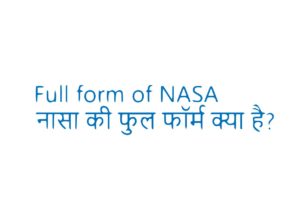What is the full form of NASA?
NASA stands for the National Aeronautics and Space Administration which works independently for the working and functioning of space programs of civilians. NASA is associated with United States Federal Government and has a major contribution in aeronautics and aerospace research.
It was established in 1958 as NACA (National Advisory Committee for Aeronautics). The motive of NACA was civilian-oriented for applications in space sciences. All the US space programs such as Apollo Moon landing, Skylab Space station, Space shuttle are the efforts of NASA.
The international space station is highly supported by NASA. They are also named for unmanned NASA launches, their countdowns and various other operations.
The objective of NASA is focused on Earth exploration with the help of Earth-observing System, Heliophysics research program by Science Mission Directorate, New horizons like robotic spacecraft missions, bug bang and other astrophysics.
Creation
NACA had been researching in rocket planes since 1946. In the start of 1950s, a challenge for the International Geophysical Year (1957 to 58) was to launch an artificial satellite. After the launch of Sputnik 1 (Soviet Union’s first satellite) on 4th October 1957, the US got concerned about their space efforts.
US Congress considered this as a threat to national security and demanded instant measures. This led to a formation of Special Committee on Space Technology by NACA on 12th January 1958. This was to conduct all the non-military space activities and the Advanced Research Projects Agency was organized in the next month to aim at space technology research for the military.
The National Aeronautics and Space Act was signed on 29 July 1958. NASA started operations on 1st October 1958.
Full form of NASA in Hindi: नैशनल एरोनॉटिक्स एंड स्पेस एडमिनिस्ट्रेशन
Space Programs
NASA has launched various space shuttle, rockets and spacecraft in manned and unmanned spaceflight programs. The first American artificial satellite was launched as the unmanned program which was sent to Earth’s orbit for communication and scientific purpose.
Also, scientific probes were sent for exploring the solar system of the Sun. Various manned programs include sending the first American to the Moon and helped the US in winning the space race by sending twelve men on the Moon from 1969 to 1972 as the Apollo Program.
Advisory Council
In the Apollo 1 accident, three astronauts were killed in 1967 and raised a national issue. Thus Congress asked NASA for an Aerospace Advisory Panel for safety and precautions in the space programs conducted by NASA. Due to the Shuttle Colombia Disaster which killed all seven crew members, the Congress demanded annual report from ASAP council.
The Space Program Advisory Council was also established by 1971 with Research & Technology Advisory Council. These 3 councils provided administrative support. By 1977, Space and research/technology council joined together and formed NASA advisory Council called NAC.
Environmental impact
The Earth’s environment is severely affected by the exhaust from the Rocket’s propulsion. Various propellants like hydrazine are highly toxic if left unburnt. The hydrocarbons used in Rockets such kerosene exhausts carbon monoxide and soot as products into the air.
Even though the amount of CO2 released is insignificant as compared to other activities involved in a normal citizen’s day to day lives. If we launch one rocket every day, it will only give to 0.006% of the total daily liquid fuel consumed and emissions.
Also, most of the exhaust gases from non-hydrocarbon fuel engines are water vapours. Constellation program of NASA was cancelled due to the environmental issues and regulations mentioned in the National Environmental Policy Act passed in 2011.
Apart from these, Ion engines make use of Noble gases such as xenon in rockets. The NASA Sustainability base represents the concerns of NASA toward environmental issues.
“Stay Informed and connect to Today’s era full form list for the latest updates.”

